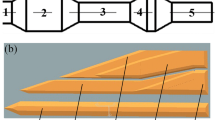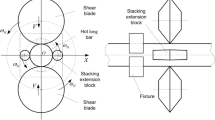Abstract
Large concavity at the end of the workpiece formed by cross wedge rolling without stub bar results in material loss. The forming process of cross wedge rolling was simulated by finite element method, revealing the reason of concavity at the end by comparing the displacement and strain with and without stub bar. A billet with a tapered end was proposed, and its optimum parameters were obtained to reduce material loss on the concavity by more than 90%. The forming quality was investigated under three typical forming conditions, and it was found that the significant increase of transverse tensile stress, shear stress and shear strain at the end centre of the workpiece formed without stub bar results in the risk of central damage. The results of finite element simulation were verified by rolling experiments, and the prediction of central damage was confirmed by the microstructure of the workpiece. As a result, a billet with an appropriate tapered end not only save materials but also avoid the risk of central damage at the end of the workpiece.
Similar content being viewed by others
References
Hu ZH, Zhang KS, Wang BY, Shu XD, Yang CP (2004) Forming technology and simulation of cross wedge rolling parts. Metall Ind Press, Beijing
Hu Z, Yang C, Wang B (2012) Development of part rolling technology in China. J Mech Eng 48(18):8–12
Behrens BA, Stonis M, Blohm T, Richter J Investigating the effects of cross wedge rolling preforming operation and die forging with flash brakes on forging titanium hip implants. Int J Mater Form. https://doi.org/10.1007/s12289-016-1329-0
Behrens BA, Stonis M, Rasche N Influence of the forming angle in cross wedge rolling on the multi-directional forging of crankshafts. Int J Mater Form. https://doi.org/10.1007/s12289-016-1326-3
Ma Z, Hu Z, Yang C, Shu X (2002) Deformation character and analysis of stress and strain during stretching stage for cross wedge rolling. J Univ Sci Technol B 24(3):309–312
Yang C, Zhang K, Du H, Hu Z (2004) Influence of area reduction of part on metal flow in cross wedge rolling. China Mech Eng 15(20):1868–1870
Yang C, Hu Z, Zhang K, Du H (2004) Study on axial deformation of workpiece in cross wedge rolling. Chin J Mech Eng 40(9):80–83
Pater Z (2006) Finite element analysis of cross wedge rolling. J Mater Process Technol 173:201–208
Zhang Y, Chen YJ, Xu CG, Ren WW, Guo YQ (2015) Numerical simulation study on cross wedge rolling end concavity under non-uniform temperature field. J Netshape Forming Eng 7:99–104
Wang MT, Li XT, Du FS (2009) Analysis of metal forming in two-roll cross wedge rolling process using finite element method. J Iron Steel Res Int 16:38–43
Jia Z, Zhou J, Ji JJ, Zhen ZZ, Xiang LD, Sun XT (2013) Influence analysis of area reduction for necking in twice-stage. Int J Adv Manuf Technol 66:1407–1413
Ji H, Liu J, Wang B, Zheng Z, Huang J, Hu Z (2015) Cross-wedge rolling of a 4Cr9Si2 hollow valve: explorative experiment and finite element simulation. Int J Adv Manuf Technol 77:15–26
Yang G, Zhang KS, Duan WZ, Hu ZH (2014) Effect of process parameters on the end scrap of no-step-end workpieces by cross wedge rolling. J Univ Sci Technol B 36:959–965
Pater Z (2011) Cross-wedge rolling of shafts with an eccentric step. J Iron Steel Res Int 18:26–30
Pater Z, Gontarz A, Tofil A (2011) Analysis of the cross-wedge rolling process of toothed shafts made from 2618 aluminium alloy. J Shanghai Jiaotong Univ 16:162–166
Yang C, Ma J, Hu Z (2017) Analysis and design of cross wedge rolling hollow axle sleeve with mandrel. J Mater Process Technol 239:346–358
Wang MH, Xiang D, Xiao C, Zhou J, Jia Z (2012) Influence of cooling condition of tools on central deformation of workpiece and tool wear in cross wedge rolling. Int J Adv Manuf Technol 59:473–482
Zhou J, Yu Y, Zeng Q (2014) Analysis and experimental studies of internal voids in multi-wedge cross wedge rolling stepped shaft. Int J Adv Manuf Technol 72:1559–1566
Peng WF, Zhang JH, Huang GX, Liu WP, Shu XD, Zhu J (2016) Stress distributions during the cross-wedge rolling of composite 42CrMo/Q235 laminated shafts. Int J Adv Manuf Technol 83:145–155
Ji H, Liu J, Wang B, Tang X, Huo Y, Zhou J, Hu Z (2016) Constitutive relationship of 4Cr9Si2 and technological parameters on the inner bore of cross wedge rolling for preform hollow valves. Int J Adv Manuf Technol 86:2621–2633
Li XT, Wang MT, Du FS (2006) The coupling thermal-mechanical and microstructural model for the FEM simulation of cross wedge rolling. J Mater Process Technol 172:202–207
Xiong Y, Sun SH, Li Y, Zhao J, Lv ZQ, Zhao DL, Zheng YZ, Fu WT (2006) Effect of warm cross-wedge rolling on microstructure and mechanical property of high carbon steel rods. Mater Sci Eng A 431:152–157
Acknowledgements
The authors gratefully acknowledge the financial support of the Beijing Laboratory of Modern Transportation Metal Materials and Processing Technology.
Author information
Authors and Affiliations
Corresponding author
Ethics declarations
Conflict of interest
The authors declare that they have no competing interests.
Rights and permissions
About this article
Cite this article
Yang, C., Zheng, Z. & Hu, Z. Simulation and experimental study on the concavity of workpiece formed by cross wedge rolling without stub bar. Int J Adv Manuf Technol 95, 707–717 (2018). https://doi.org/10.1007/s00170-017-1252-7
Received:
Accepted:
Published:
Issue Date:
DOI: https://doi.org/10.1007/s00170-017-1252-7




